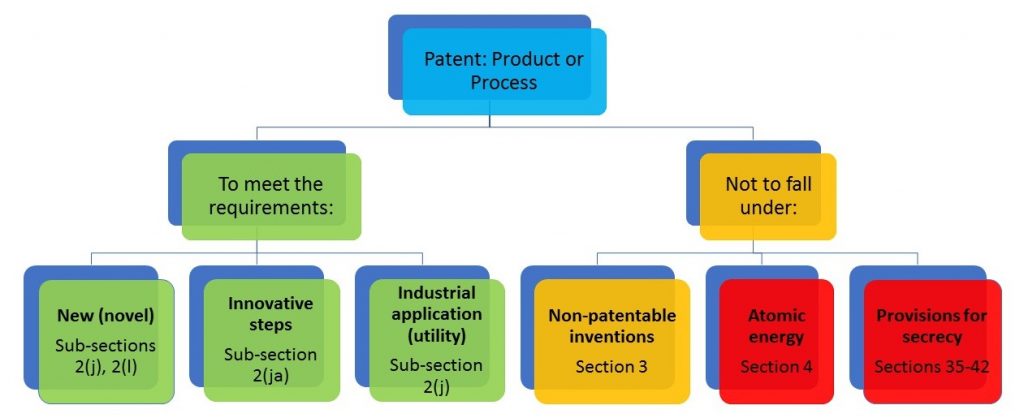Dear readers, welcome to the last post about patentable inventions. Before starting this specific article on inventions subject to security and secrecy, let us once look back to the complete picture. According to the Patents Act, 1970 a product or process is patentable if it meets certain defined requirements. Further, the Act defines what are not inventions or not patentable. It also has a provision to deny patent for national security and secrecy reasons. An inventor needs to be aware of all these provisions while assessing patentability of his work. Looking at Figure 1 below one can get a simple yet complete view covering all these provisions.
Figure 1: Patent – What to Meet and What to Avoid
Explanation of the first two areas (green and amber blocks in Figure 1) are part of the following articles:
In the current article we will see where the Patent Office can deny a patent to an otherwise patentable invention to protect national security and secrecy (red blocks in Figure 1). This provision prevents sensitive technologies from appearing in public domain.
Inventions related to atomic energy
The Patents Act prohibits patents to inventions relating to atomic energy [ref. 1]. This, in line with the Atomic Energy Act, 1962 [ref. 2], denies patent for inventions ranging from mining till disposal of atomic energy.
Accordingly, for inventions potentially related to atomic energy, the Patent Office, advised by the Department of Atomic Energy (DAE), may deny to grant patents. Such decisions are final and one cannot appeal against them. The Central Government may also directly examine any patent application for this purpose. Every year the Patent Office send a good number of applications to the DAE for examination and deny patent for a part of these applications. Figure 2 below gives a glimpse of all such cases between 2010-11 and 2015-16 [ref. 3]. 
Figure 2: Statistics of Inventions Subject to Atomic Energy
Even if such an invention is granted a patent, the Central Government, on finding so, may direct the Patent Office to revoke the same [ref. 4]. However, as per the Act the Patent Office give the patentee an opportunity for hearing before revoking the patent.
It is noteworthy that the Indian patent law does not differentiate between atomic energy and atomic weapons; simply all inventions in the realm of radioactivity fall under this provision. An example is Merck & CIE’s medicine that was rejected for being related to atomic energy. Unlike India some countries like the USA separate innovations related to atomic weapons and not atomic weapons, and may grant patents for the latter group [ref. 5]. A few of these patents are example 1, example 2 etc.
A further checkpoint is in place under the act that prevents bypassing the Indian system and directly filing a foreign patent application [ref. 6]. A direct application to another country cannot happen without the Patent Office’s written permission [ref. 6]. Usually one has to first file a patent application with the Indian Patent Office.
Tips: Remember that atomic energy related inventions are not patentable in India.
inventions subject to secrecy
Apart from the atomic energy related inventions there are restrictions for inventions relevant to defence purposes. Usually such inventions are not published and not granted patents until the Central Government examine them [ref. 7].
The Central Government notify the Patent Office through secrecy directions about such inventions and review relevance of certain types of inventions every six months [ref. 8]. These directives are not available to public but generally one can expect inventions related to weapons, war equipment, aircraft, unmanned aerial vehicle (UAV) etc. as some potential cases.
The Defense Research & Development Organisation (DRDO), on behalf of the Government, examine such patent applications for threat to the nation. The Patent Office grant or deny a patent based on this examination. None of the orders of the Central Government in this regard is questionable in any court on any ground whatsoever [ref. 9]. See Figure 3 below for those cases between 2010-11 and 2015-16 [ref. 3].
Figure 3: Statistics of Inventions Subject to Secrecy
As seen in the earlier section an Indian resident can apply outside India only if he has a written permission from the Patent Office or at least six weeks have passed from the time of application in India for the same invention [ref. 6]. The Patent Office can revoke a patent if a security threat is identified later [ref. 10].
In some instances the Central Government may choose to use such an invention for their own purpose any they may compensate the applicant [ref. 11].
Tips: Remember that inventions related to defence can be denied patents under the secrecy directions.
summary
The Patent Act clearly defines the criteria for an invention to be patentable. The Act also identifies cases which are not inventions. In this article we have seen that all inventions related to atomic energy are not patentable in India. Further, defence related inventions may be denied patents if the Central Government find their availability in the public domain may compromise national security. Knowing about these provisions of the act equips one with enough understanding to assess patentability of his invention.
Thank you all for showing interest in the articles published in this website. Please feel free to seek further clarifications, if you need so.
References:
The following sections/sub-sections of the Patents Act, 1970, except for the specific acts/reports mentioned where applicable:
- 4 – Inventions relating to atomic energy not patentable
- Sub-section 20 (1) of the Atomic Energy Act, 1962
- IP India Annual Reports
- 65 – Revocation of patent or amendment of complete specification on directives from Government in cases relating to atomic energy
- Section 151-160 of the (USA) Atomic Energy Act of 1954
- 39 – Residents not to apply for patents outside India without prior permission
- 35 – Secrecy directions relating to inventions relevant for defence purposes
- 36 – Secrecy directions to be periodically reviewed
- 41 – Finality of orders of Controller and Central Government
- 40 – Liability for contravention of section 35 or section 39
- 37(2) – Consequences of secrecy directions
About the author: The author is a mechanical Engineering student trained in Intellectual Property Rights. Through this article he intends to share his learning about patent with those interested in patents.
Next Article: The next article will explain about the patent application rules and is likely to be available in June 2018.

